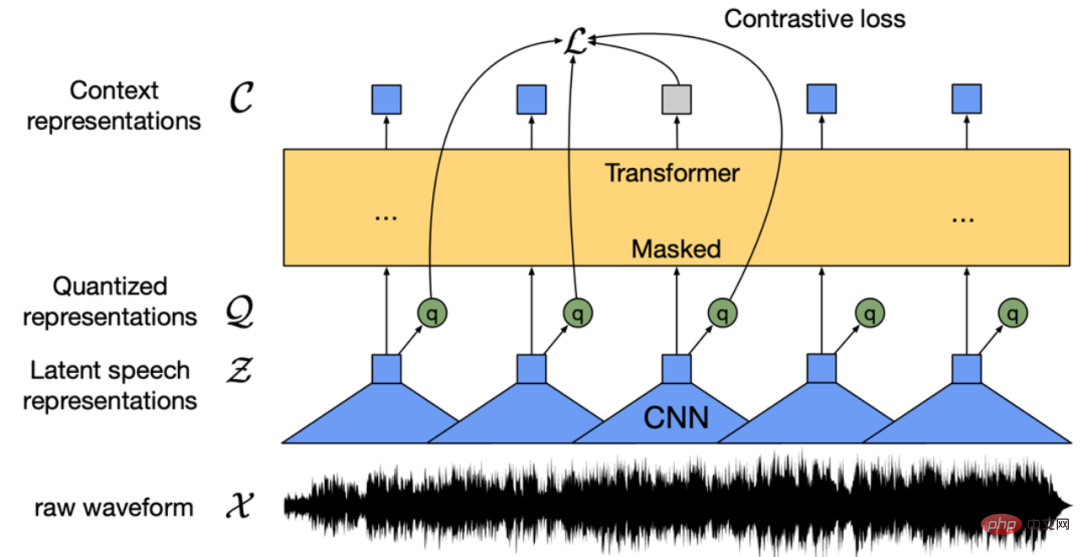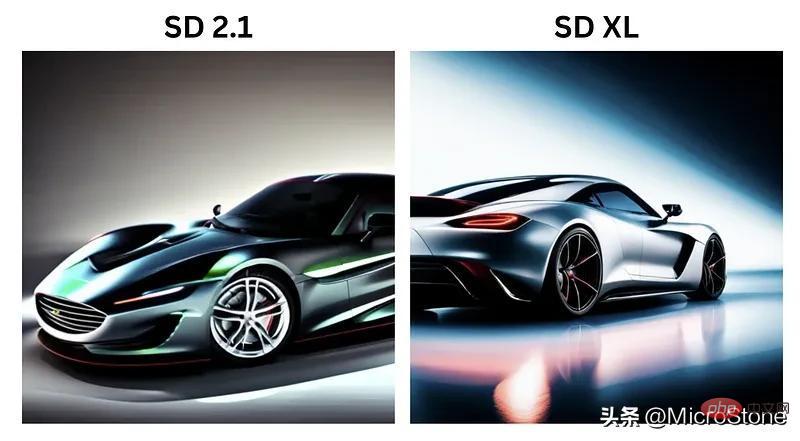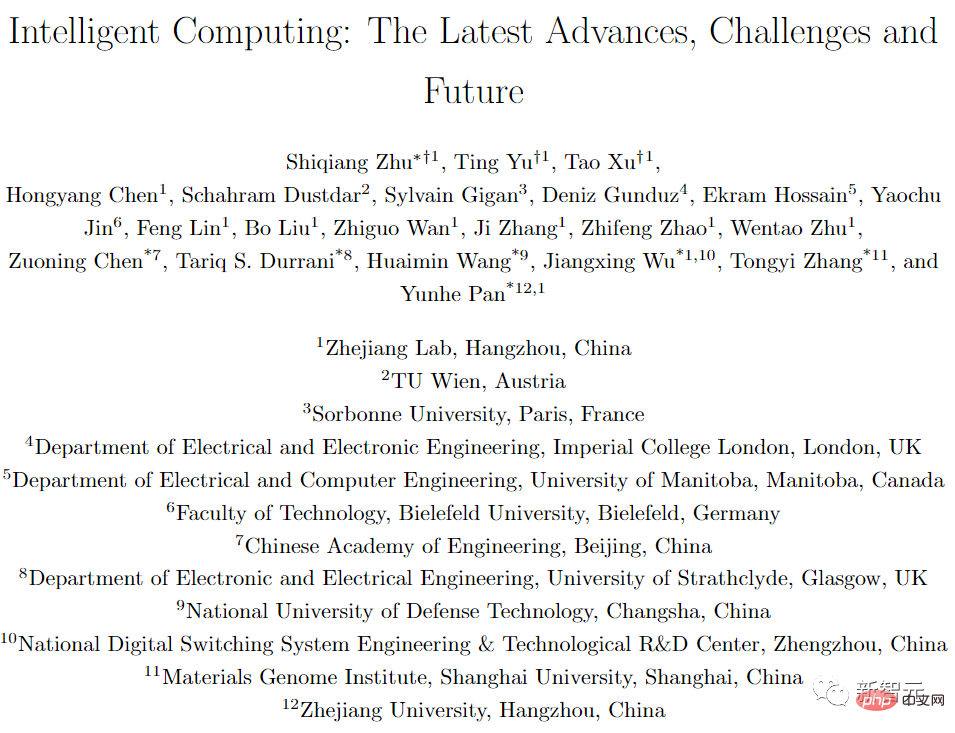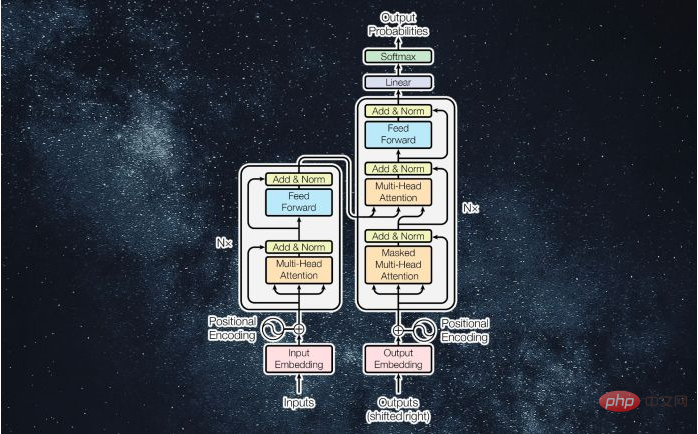 Technology peripherals
Technology peripherals AI
AI Transformer imitates the brain, surpassing 42 models in predicting brain imaging, and can also simulate the transmission between the senses and the brain
Transformer imitates the brain, surpassing 42 models in predicting brain imaging, and can also simulate the transmission between the senses and the brainMany AI application models now have to mention a model structure:
Transformer.
It abandons traditional CNN and RNN and is entirely composed of Attention mechanism.
Transformer not only gives various AI application models the ability to write articles and poems, but also shines in multi-modal aspects.
Especially after the release of ViT (Vision Transformer), the model barrier between CV and NLP has been broken, and only one Transformer model can handle multi-modal tasks.
(No one can say how powerful it is after reading this)
Although Transformer was originally designed for language tasks, it also has great potential in imitating the brain.
No, a science writer wrote a blog about how Transformer models the brain.

What did he say when he came to Kangkang?
Transformer: Do what the brain does
First of all, we have to sort out its evolution process.
The Transformer mechanism first appeared 5 years ago. Its ability to perform so powerfully is largely due to its Self-attention mechanism.
As for how Transformer imitates the brain, continue reading.
In 2020, the research team of Austrian computer scientist Sepp Hochreiter used Transformer to reorganize the Hopfield neural network (a memory retrieval model, HNN).
In fact, the Hopfield neural network was proposed 40 years ago, and the reason why the research team chose to reorganize this model after decades is as follows:
First, this network follows a A general rule: Neurons that are active at the same time establish strong connections with each other.
Second, the Hopfield neural network has certain similarities in the process of retrieving memory and the Transformer's implementation of the Self-attention mechanism.
So the research team reorganized HNN to establish better connections between neurons so that more memories can be stored and retrieved.
The process of reorganization, simply put, is to integrate the attention mechanism of Transformer into HNN, so that the original discontinuous HNN becomes a continuous state.

△Source: Wikipedia
The reorganized Hopfield network can be integrated into a deep learning architecture as a layer to allow storage and access of the original input data , intermediate results, etc.
Therefore, Hopfield himself and Dmitry Krotov of the MIT Watson Artificial Intelligence Laboratory both said:
The Hopfield neural network based on Transformer is biologically reasonable.
Although this is similar to how the brain works to a certain extent, it is not accurate enough in some aspects.
So computational neuroscientists Whittington and Behrens adapted Hochreiter's method and made some modifications to the reorganized Hopfield network, further improving the model's performance in neuroscience tasks such as replicating neural firing patterns in the brain. )Performance.

△Tim Behrens (left) James Whittington (right) Source: quantamagazine
To put it simply, during encoding-decoding, the model no longer Instead of encoding memories as linear sequences, encode them as coordinates in a high-dimensional space.
Specifically, TEM (Tolman-Eichenbaum Machine) is introduced into the model.
TEM is an associative memory system built to imitate the spatial navigation function of the hippocampus.
It is able to generalize spatial and non-spatial structural knowledge, predict neuronal performance observed in spatial and associative memory tasks, and explain remapping phenomena in the hippocampus and entorhinal cortex.
Merge TEM and Transformer, which have so many functions, to form TEM-transformer (TEM-t).
Then, let the TEM-t model be trained in multiple different spatial environments. The structure of the environment is as shown in the figure below.

In TEM-t, it still has the Self-attention mechanism of Transformer. In this way, the model's learning results can be transferred to new environments and used to predict new spatial structures.
Research also shows that compared to TEM, TEM-t is more efficient in performing neuroscience tasks, and it can also handle more problems with fewer learning samples.

Transformer is getting deeper and deeper in imitating brain patterns. In other words, the development of Transformer patterns is also constantly promoting our understanding of the operating principles of brain functions.
Not only that, in some aspects, Transformer can also improve our understanding of other functions of the brain.
Transformer helps us understand the brain
For example, last year, computational neuroscientist Martin Schrimpf analyzed 43 different neural network models to observe their effects on human neural activity measurements: Functional Magnetism Predictive power of resonance imaging (fMRI) and cortical electroencephalography (EEG) reports.
Among them, the Transformer model can predict almost all changes found in imaging.
Looking back, perhaps we can also predict the operation of the corresponding functions of the brain from the Transformer model.
In addition, computer scientists Yujin Tang and David Ha recently designed a model that can consciously send large amounts of data in a random and disordered manner through the Transformer model, simulating how the human body transmits sensory observations to the brain. .
This Transformer is like the human brain and can successfully process disordered information flow.
Although the Transformer model continues to improve, it is only a small step towards an accurate brain model, and more in-depth research is needed to reach the end.
If you want to learn more about how Transformer imitates the human brain, you can click on the link below~
Reference link:
[1]https://www.quantamagazine.org /how-ai-transformers-mimic-parts-of-the-brain-20220912/
[2]https://www.pnas.org/doi/10.1073/pnas.2105646118
[3]https://openreview.net/forum?id=B8DVo9B1YE0
The above is the detailed content of Transformer imitates the brain, surpassing 42 models in predicting brain imaging, and can also simulate the transmission between the senses and the brain. For more information, please follow other related articles on the PHP Chinese website!
 从VAE到扩散模型:一文解读以文生图新范式Apr 08, 2023 pm 08:41 PM
从VAE到扩散模型:一文解读以文生图新范式Apr 08, 2023 pm 08:41 PM1 前言在发布DALL·E的15个月后,OpenAI在今年春天带了续作DALL·E 2,以其更加惊艳的效果和丰富的可玩性迅速占领了各大AI社区的头条。近年来,随着生成对抗网络(GAN)、变分自编码器(VAE)、扩散模型(Diffusion models)的出现,深度学习已向世人展现其强大的图像生成能力;加上GPT-3、BERT等NLP模型的成功,人类正逐步打破文本和图像的信息界限。在DALL·E 2中,只需输入简单的文本(prompt),它就可以生成多张1024*1024的高清图像。这些图像甚至
 普林斯顿陈丹琦:如何让「大模型」变小Apr 08, 2023 pm 04:01 PM
普林斯顿陈丹琦:如何让「大模型」变小Apr 08, 2023 pm 04:01 PM“Making large models smaller”这是很多语言模型研究人员的学术追求,针对大模型昂贵的环境和训练成本,陈丹琦在智源大会青源学术年会上做了题为“Making large models smaller”的特邀报告。报告中重点提及了基于记忆增强的TRIME算法和基于粗细粒度联合剪枝和逐层蒸馏的CofiPruning算法。前者能够在不改变模型结构的基础上兼顾语言模型困惑度和检索速度方面的优势;而后者可以在保证下游任务准确度的同时实现更快的处理速度,具有更小的模型结构。陈丹琦 普
 找不到中文语音预训练模型?中文版 Wav2vec 2.0和HuBERT来了Apr 08, 2023 pm 06:21 PM
找不到中文语音预训练模型?中文版 Wav2vec 2.0和HuBERT来了Apr 08, 2023 pm 06:21 PMWav2vec 2.0 [1],HuBERT [2] 和 WavLM [3] 等语音预训练模型,通过在多达上万小时的无标注语音数据(如 Libri-light )上的自监督学习,显著提升了自动语音识别(Automatic Speech Recognition, ASR),语音合成(Text-to-speech, TTS)和语音转换(Voice Conversation,VC)等语音下游任务的性能。然而这些模型都没有公开的中文版本,不便于应用在中文语音研究场景。 WenetSpeech [4] 是
 解锁CNN和Transformer正确结合方法,字节跳动提出有效的下一代视觉TransformerApr 09, 2023 pm 02:01 PM
解锁CNN和Transformer正确结合方法,字节跳动提出有效的下一代视觉TransformerApr 09, 2023 pm 02:01 PM由于复杂的注意力机制和模型设计,大多数现有的视觉 Transformer(ViT)在现实的工业部署场景中不能像卷积神经网络(CNN)那样高效地执行。这就带来了一个问题:视觉神经网络能否像 CNN 一样快速推断并像 ViT 一样强大?近期一些工作试图设计 CNN-Transformer 混合架构来解决这个问题,但这些工作的整体性能远不能令人满意。基于此,来自字节跳动的研究者提出了一种能在现实工业场景中有效部署的下一代视觉 Transformer——Next-ViT。从延迟 / 准确性权衡的角度看,
 Stable Diffusion XL 现已推出—有什么新功能,你知道吗?Apr 07, 2023 pm 11:21 PM
Stable Diffusion XL 现已推出—有什么新功能,你知道吗?Apr 07, 2023 pm 11:21 PM3月27号,Stability AI的创始人兼首席执行官Emad Mostaque在一条推文中宣布,Stable Diffusion XL 现已可用于公开测试。以下是一些事项:“XL”不是这个新的AI模型的官方名称。一旦发布稳定性AI公司的官方公告,名称将会更改。与先前版本相比,图像质量有所提高与先前版本相比,图像生成速度大大加快。示例图像让我们看看新旧AI模型在结果上的差异。Prompt: Luxury sports car with aerodynamic curves, shot in a
 五年后AI所需算力超100万倍!十二家机构联合发表88页长文:「智能计算」是解药Apr 09, 2023 pm 07:01 PM
五年后AI所需算力超100万倍!十二家机构联合发表88页长文:「智能计算」是解药Apr 09, 2023 pm 07:01 PM人工智能就是一个「拼财力」的行业,如果没有高性能计算设备,别说开发基础模型,就连微调模型都做不到。但如果只靠拼硬件,单靠当前计算性能的发展速度,迟早有一天无法满足日益膨胀的需求,所以还需要配套的软件来协调统筹计算能力,这时候就需要用到「智能计算」技术。最近,来自之江实验室、中国工程院、国防科技大学、浙江大学等多达十二个国内外研究机构共同发表了一篇论文,首次对智能计算领域进行了全面的调研,涵盖了理论基础、智能与计算的技术融合、重要应用、挑战和未来前景。论文链接:https://spj.scien
 什么是Transformer机器学习模型?Apr 08, 2023 pm 06:31 PM
什么是Transformer机器学习模型?Apr 08, 2023 pm 06:31 PM译者 | 李睿审校 | 孙淑娟近年来, Transformer 机器学习模型已经成为深度学习和深度神经网络技术进步的主要亮点之一。它主要用于自然语言处理中的高级应用。谷歌正在使用它来增强其搜索引擎结果。OpenAI 使用 Transformer 创建了著名的 GPT-2和 GPT-3模型。自从2017年首次亮相以来,Transformer 架构不断发展并扩展到多种不同的变体,从语言任务扩展到其他领域。它们已被用于时间序列预测。它们是 DeepMind 的蛋白质结构预测模型 AlphaFold
 AI模型告诉你,为啥巴西最可能在今年夺冠!曾精准预测前两届冠军Apr 09, 2023 pm 01:51 PM
AI模型告诉你,为啥巴西最可能在今年夺冠!曾精准预测前两届冠军Apr 09, 2023 pm 01:51 PM说起2010年南非世界杯的最大网红,一定非「章鱼保罗」莫属!这只位于德国海洋生物中心的神奇章鱼,不仅成功预测了德国队全部七场比赛的结果,还顺利地选出了最终的总冠军西班牙队。不幸的是,保罗已经永远地离开了我们,但它的「遗产」却在人们预测足球比赛结果的尝试中持续存在。在艾伦图灵研究所(The Alan Turing Institute),随着2022年卡塔尔世界杯的持续进行,三位研究员Nick Barlow、Jack Roberts和Ryan Chan决定用一种AI算法预测今年的冠军归属。预测模型图


Hot AI Tools

Undresser.AI Undress
AI-powered app for creating realistic nude photos

AI Clothes Remover
Online AI tool for removing clothes from photos.

Undress AI Tool
Undress images for free

Clothoff.io
AI clothes remover

AI Hentai Generator
Generate AI Hentai for free.

Hot Article

Hot Tools

MinGW - Minimalist GNU for Windows
This project is in the process of being migrated to osdn.net/projects/mingw, you can continue to follow us there. MinGW: A native Windows port of the GNU Compiler Collection (GCC), freely distributable import libraries and header files for building native Windows applications; includes extensions to the MSVC runtime to support C99 functionality. All MinGW software can run on 64-bit Windows platforms.

DVWA
Damn Vulnerable Web App (DVWA) is a PHP/MySQL web application that is very vulnerable. Its main goals are to be an aid for security professionals to test their skills and tools in a legal environment, to help web developers better understand the process of securing web applications, and to help teachers/students teach/learn in a classroom environment Web application security. The goal of DVWA is to practice some of the most common web vulnerabilities through a simple and straightforward interface, with varying degrees of difficulty. Please note that this software

Atom editor mac version download
The most popular open source editor

VSCode Windows 64-bit Download
A free and powerful IDE editor launched by Microsoft

Dreamweaver CS6
Visual web development tools






